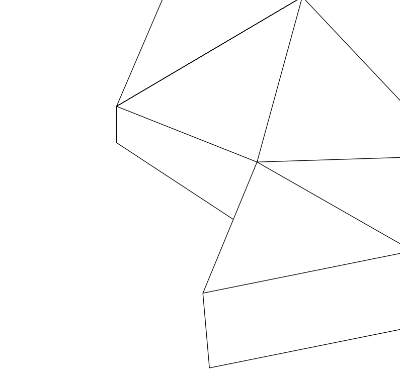
General Introduction of the Project
Introduction from the Editors
The main objective of the Analogue game for digital minds – Logifaces methodology project was to create new visual study material for mathematics, science and art education. The project is based on Logifaces, which is a spatial geometry, logic and sensorimotor skill development game.[br][br]The novelty value of Logifaces lies in the three dimensional shift compared to the two dimensional nature of[br]traditional logic puzzle games. Contrary to the majority of traditional and contemporary logic games and school toolkits, Logifaces deals with spatial geometry. Instead of using colours, with different shapes Logifaces focuses on all three dimensions. The end result in the game is a tactile spatial surface highlighting the relationship between basic geometry and complex organic forms. A further important feature of the game from the point of view of STEAM subjects is its artistic value. The nature of light-shadow effects can be studied through the variously sloping blocks. In addition the continuous surface resembles ancient reliefs.[br][br]The Logifaces book contains Art, Mathematics, Science and Interdisciplinary exercises. We placed great[br]emphasis on the connection between various subjects and subtopics to accentuate the STEAM nature of the[br]exercises. Each exercise can be found on the GeoGebra website (geogebra.org) too in pdf format.[br]The methodology book was created by teachers, artists, theorists and educational professionals. The five[br]partner organisations (from Austria, Finland, Hungary, and Serbia) come from various regions of Europe and[br]operate in different education systems. The different approaches greatly enriched the results; however, the STEAM approach was always a common basis. Here we would like to thank all of them for their hard work and enthusiasm despite the difficulties of the Covid-19 situation.[br][br]Development of the methodology does not stop here, and we are open to new ideas! Please contact[br]us at daniel@planbureau.hu[br][br]Dániel Lakos and Eszter Losonczi (editors)

Inventing the Game
The Jump from Paper
The story of the Logifaces game started in 2012 when we were invited to submit a tender to MOME’s toy design project, 1359 cm3. I came up with the concept over the course of just one night. I was thinking of introducing a three-dimensional shift into an existing two-dimensional game, Tantrix. Just like in Tantrix, you need to connect the elements according to a simple rule. Logifaces is more similar to Triomino, however, I did not know about Triomino at that time. Right after that, the very next morning we sketched up the various elements, which still remain the same today. The jury chaired by Ernő Rubik selected our design to be one of the finalists. A year later, in 2013, we won the Hungarian Design Award.[br][br]After the Design Award, we came up with the idea to use concrete, which has low investment costs for series production, instead of the more complicated and commonplace wood. In 2014, our design, now ready for mass production, debuted on the Indiegogo crowdfunding platform. The goal was 15,000 USD, which we managed to almost double with about 300 sets sold.[br][br]The concrete version became a special design object, a tabletop sculpture, and a frequent choice as a souvenir or a gift. This led us to introduce a wooden version as well, suitable for children and people who are more interested in playing than owning a design product.[br][br]Daniel Lakos — designer, inventor of the game
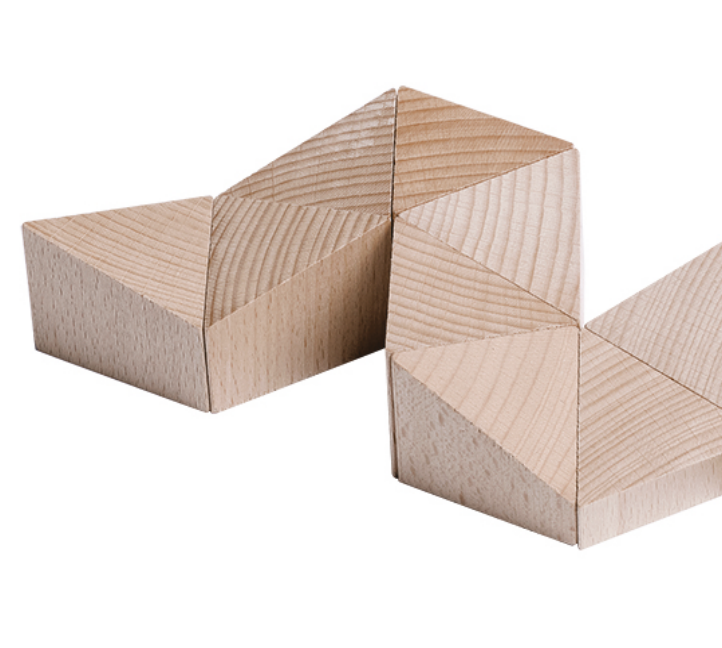
Professor László Mérő reviewed the game on this occasion
Good problem solving is the basis of everything, both in mathematics and design. Without this, we cannot[br]come up with solutions that overwrite our fixed schemes. This spirit of innovation and the search for innovative solutions characterises the creations in the design category. Why do we need new kinds of games? Isn’t the fruit of the last few thousand years enough, from dice to the Rubik’s cube, from the cob doll to the Barbie doll? One childhood is not enough for these either, and not even a whole life. But just as we need new literary works despite the fact that we haven’t even read the old ones, we also need new games that somehow resonate with our lives today. The toy, which was awarded this year’s Hungarian Design Award, presents a theme that is thousands of years old in a modern guise. Puzzle games already existed in ancient Babylon, but this game could not have existed then, as it is inspired by today’s computer graphics toolkit. That’s why we immediately feel at home. It’s good to think. More precisely: it is good to think in moderation, just as it is good to drink in moderation or climb a mountain. Many of us like to climb mountains, but few of us like to climb the Himalayas. The thing about good puzzle games is that they require just as much thinking as they are enjoyable, and as much as the joy of finding the solution is more than worth the sacrifice made for it, the mental effort. Psychologists have shown that the greatest pleasure comes from tasks that are medium to difficult, but not too difficult. This excludes not only tasks that are too difficult, but also tasks that are too easy: they may require little effort, but they are not worth that much. This prize-winning work in the design category has hit the level of difficulty that creates a pleasant challenge exactly, its clean formality playfully draws you into the complex world of spatial geometry.
The Logifaces Game
Shapes and Slopes
The game Logifaces consists of blocks forming prisms with a triangular top and bottom and different heights of the corners. This leads to varying slopes and area sizes of the sides of each block.The goal of the game is to form shapes with a continuous top surface. To create this, blocks with a similar side surface have to be selected and arranged accordingly. In the chapter on the Logifaces methodology the design and structure of the game will be explained in more detail. There is a broad variety of possible activities with Logisfaces, which offer challenges of a wide range of degrees of difficulty. This wide range offers the possibility for many age groups to find a suitable and fun activity.
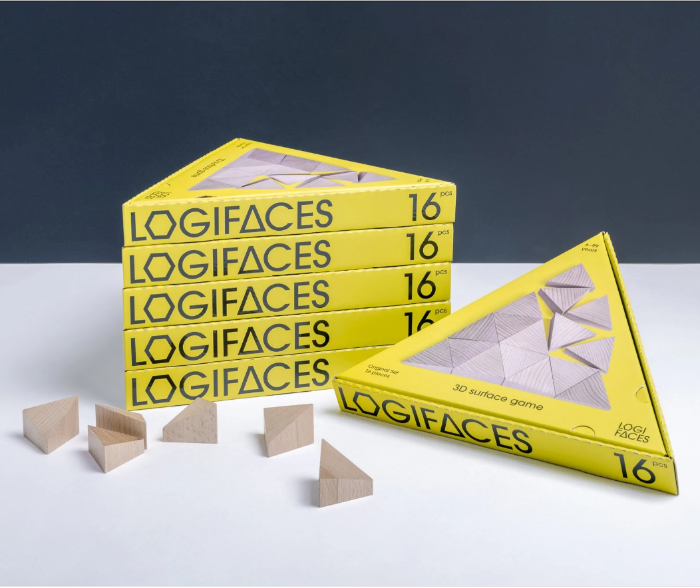
The Logifaces Book for Downloading
Please download the book here in case you would like to re-read or print parts of the book or exercises.
Studies - Searchable Version
The PDF Version [b]does not contain images.[/b][br]However, it is [b]searchable[/b]. If you want to find links to eg. other studies, skim through these studies!
Studies - Images Version
The PDF Version [b]contains images.[/b][br]However, it is [b]not searchable.[/b]
Introduction: Maths / Math chapters
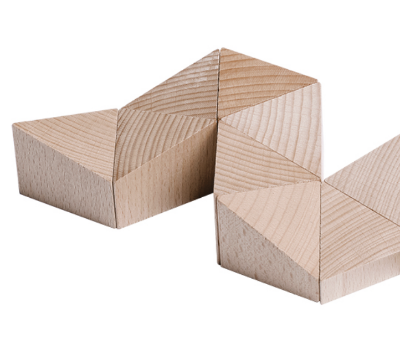
The book is designed to provide tasks for all age groups with different levels of prior knowledge, ability and diverse interests. The exercises are grouped by topic. The levels of difficulty are noted as follows: S - standard, A - advanced, AS - suitable for differentiation. The age groups are based on the Mathematics Syllabus of Hungary and are similar to the grades in the UK and most European school systems. There are exercises for individual, pair and group work. [br][br]The exercises consist of 4 parts: [br][list=1][*]Description[/*][*]Solutions/Examples[/*][*]Prior Knowledge [/*][*]and Recommendations/Comments. [/*][/list]The Description contains the instructions for the exercises which are often given in different Levels. Unless otherwise stated in the Recommendations/Comments part, the Levels are in order of increasing difficulty. Further guidelines can be found in the Recommendations/Comments part alongside the list of exercises to be solved before or after the exercise. When there is an exercise recommended to be solved beforehand, the duration is determined assuming that the solutions of the prerequisite are known.
[b][size=150][url=https://www.geogebra.org/m/jdtsvxye][img]https://www.geogebra.org/resource/dbct9vwj/KLNgJXXEi4ENaIQS/material-dbct9vwj.png[/img] [img]https://www.geogebra.org/resource/kzb8btnw/BFFApXvggX4MvbHe/material-kzb8btnw.png[/img][br]Chapter 1: Intro and Games[/url][/size][/b][br]The exercises found in the Intro topic are specifically designed to get students familiar with the Logifaces Set and with the rules of building Logifaces constructions. We recommend starting with these exercises to practise the notations and terminology used throughout the whole Maths part. The games can be played to improve logical thinking and spatial vision and also to have fun with the Logifaces Set whenever there is an opportunity to play in the class.[br][br][url=https://www.geogebra.org/m/jdtsvxye]Find all Intro and Games exercises here[/url]
[b][size=150][url=https://www.geogebra.org/m/mek9rzzb][img]https://www.geogebra.org/resource/pthmpfa9/QRqEGfVJichayvvY/material-pthmpfa9.png[/img][br]Chapter 2: Logical thinking[/url][/size][/b][br]This chapter contains a variety of exercises to improve logical thinking skills (from easier tasks for lower grades to those requiring more complex mathematical thinking, like proofs) in the Logic topic, while the exercises of the Graphs topic can be used as an introduction to this mathematical domain.[br][br][url=https://www.geogebra.org/m/mek9rzzb]Find all Logical Thinking exercises here[/url]
[b][size=150][url=https://www.geogebra.org/m/hcbddq6j][img]https://www.geogebra.org/resource/jbweynwr/wCQNFpF4ut1fnYxb/material-jbweynwr.png[/img] [img]https://www.geogebra.org/resource/gkcj5ubw/9KidtUhRDgOImcdx/material-gkcj5ubw.png[/img][br]Chapter 3: Numbers and Sequences[/url][/size][/b][br]This chapter contains fun and playful exercises to practise basic operations and arithmetics. Students can learn about number systems and in the Sequences topic there are more challenging tasks, involving proofs.[br][br][url=https://www.geogebra.org/m/hcbddq6j]Find all Numbers and Sequences exercises here[/url]
[b][size=150][url=https://www.geogebra.org/m/t6em567e][img]https://www.geogebra.org/resource/mcktgha2/3abBAqYRU8SdOI08/material-mcktgha2.png[/img][br]Chapter 4: 2D Geometry[/url][/size][/b][br]In this chapter the reader can find exercises for practising basic geometrical concepts such as recognizing different types of polygons, measuring angles, finding the perimeter and the area for polygons, using the Pythagorean theorem and Heron’s formula. In addition to the tasks in the Intro part, these exercises provide further opportunity to get familiar with the Logifaces Sets and the blocks themselves. [br]Additional practical information relating to this chapter:[br][list][*]If not mentioned otherwise, the parameters of the blocks are measured in standard units[br][/*][*]The notation |AB| stands for the length of the segment AB[/*][/list][br][url=https://www.geogebra.org/m/t6em567e]Find all 2D Geometry exercises here[/url]
[img]https://www.geogebra.org/resource/ustcdx69/JtR18BlLvkdMlwZx/material-ustcdx69.png[/img][br][b][size=150][url=https://www.geogebra.org/m/raq4wnfr]Chapter 5: 3D Geometry[/url][/size][/b][br]This chapter covers the following topics: Surface area and Volume calculations, Trigonometry, Transformations, Coordinate geometry and Nets. Most tasks are designed to improve spatial vision, whether through craft, manipulation of digital models or working through calculations.[br]Additional practical information relating to this chapter: [br][list][*]Axial symmetry means that the shape is symmetrical to the reflection about some line in 3D. [br][/*][*]In the Transformations topic all rotations are anticlockwise rotations, unless otherwise stated. [br][/*][*]In some exercises there is a need for other tools beside the Logifaces Sets, such as plasticine or straws. [br][/*][*]Some exercises need access to GeoGebra. In all the other exercises we also recommend the use of GeoGebra, as all the illustrations can be opened in it.[/*][/list][br][url=https://www.geogebra.org/m/raq4wnfr]Find all 3D Geometry exercises here[/url]
[b][size=150][url=https://www.geogebra.org/m/h38jt6kf][img]https://www.geogebra.org/resource/r9p7rzph/xD5YIb5E8puFY8X3/material-r9p7rzph.png[/img] [img]https://www.geogebra.org/resource/dyzhjfkx/wQwBhBvBV5aUQ7aI/material-dyzhjfkx.png[/img][br]Chapter 6: Combinatorics and Probability[/url][/size][/b][br]This chapter contains exercises with a wide range of difficulty, where the emphasis is often on the reasoning, not just the final answer. As both Combinatorics and Probability are among the less intuitive topics, students often struggle with it and need significant support from their teacher to understand and communicate their own thinking. The Solutions/Examples parts in this chapter generally only show one way of approaching the task, please note that at times there are several correct processes.[br]Additional practical information relating to this chapter: [br][list][*]Prism 333, 444 or 555 refers to a prism built from two Logifaces blocks that has a height of 3, 4 or 5 units. [br][/*][*]We use the notation Cnk for "n choose k", the number of ways to choose an (unordered) subset of k elements from a fixed set of n elements, so Cnk=n!k!(n-k)!.[br][/*][*]Probability of an event: [br][/*][/list]Pr(event)=number of favourable outcomestotal number of outcomes, where all outcomes are equally likely.[br][list][*]By Total number of outcomes we refer to the whole 9 or 16 pcs Logifaces Set, instead of the total 11 different existing Logifaces pieces.[br][/*][*]The addition rule of probability states for two events A and B that[br][/*][/list] P(AB)=P(A)+P(B)-P(AB).[br][br][url=https://www.geogebra.org/m/h38jt6kf]Find all Combinatorics and Probability exercises here[/url]
1 - Triangle Dance
[tr][td][br][table][tr][td][br]Grades 1 - 12[br][br]Duration: 20 min[br][br]Tools: one Logifaces set[br][br]Group work[br][br]Keywords: Movement[br][br][br][br][/td][td][img]https://www.geogebra.org/resource/atmvfmra/pKGw0fkjDWKZNxYT/material-atmvfmra.png[/img][/td][td][size=150][b][/b][center]Triangle Dance[/center][center][b][/b][/center][/size][table][tr][td][table][tr][/tr][/table][center][/center][table][tr][/tr][/table] [img]https://www.geogebra.org/resource/haq5z6ae/iThjSVMzUxjltBA2/material-haq5z6ae.png[/img] [/td][/tr][tr][td][size=150][b][center]INTERDISCIPLINARY[/center][/b][br][/size][/td][/tr][tr][td][br][/td][/tr][/table][/td][td][img]https://www.geogebra.org/resource/atmvfmra/pKGw0fkjDWKZNxYT/material-atmvfmra.png[/img][/td][td][img]https://www.geogebra.org/resource/mtuymvrb/w4RGGbmmPRjfnjNR/material-mtuymvrb.png[/img][/td][/tr][/table]__________________________________________________________________________________________________________________________________________[/td][/tr][tr][td][/td][/tr]
Interactive Science Exercises
Interaction with Science!
For some of the exercises, we added parts where your students can interact, rotate, watch, play with additional online GeoGebra applets that help them resolve the exercise.[br]This can be especially useful for you in case of hybrid teaching or in flipped classroom scenarios.[br][br]Read more about that in a [url=https://www.geogebra.org/m/pghjyunt#material/vmqtudfd]detailed explanation.[br][br][/url]The icons below indicate which extra the respective exercise has.[br]The exercises with the GeoGebra Classroom hat [img]https://www.geogebra.org/resource/cq9kjcah/NNpsrDIP28MNZISA/material-cq9kjcah.png[/img] indicates an interactive question or an input possibility from students that might be used in your personal GeoGebra classroom. For that, make a copy of the exercise to your personal account and [url=https://www.geogebra.org/m/pghjyunt#material/vmqtudfd]follow instructions[/url].[br]The exercises with the blue symbols [img]https://www.geogebra.org/resource/xcuxcm4x/6g6SxaxidQ4zJ17m/material-xcuxcm4x.png[/img] indicate visual applets we added to the exercises. They are interactive and can be used to rotate to look at specific cases in depth or to even play with an exercise. You can also use and mix them with questions we created or you might want your students to solve.[br]If you find this icon [img]https://www.geogebra.org/resource/xz95cnnu/Gvf8rg8zTtqPUQ5w/material-xz95cnnu.png[/img], it means we provided a video with further explanation.[br][br]
1 - [url=https://www.geogebra.org/m/zvgdbfbr]Pressure of Faces[/url] - [img]https://www.geogebra.org/resource/cq9kjcah/NNpsrDIP28MNZISA/material-cq9kjcah.png[/img][br]2 - [url=https://www.geogebra.org/m/sc3mgnkp]Optics[/url] - [img]https://www.geogebra.org/resource/cq9kjcah/NNpsrDIP28MNZISA/material-cq9kjcah.png[/img][br]4 - [url=https://www.geogebra.org/m/sxcyh3dh]Density, Volume[/url] - [img]https://www.geogebra.org/resource/cq9kjcah/NNpsrDIP28MNZISA/material-cq9kjcah.png[/img][br]
Introduction to Art Tasks
Learning methods and main topics in art education
Logifaces Art exercises cover three major topics and are recommended for three school age-groups: grades 1 to 4, grades 5 to 8 and grades 9 to 12.[br]There are two types of Logifaces exercise: visual exercises and art technique exercises.[br]All the Logifaces Art exercises in the two major topics contain icons indicating the basic design elements that characterise the specific exercise. There are seven icons and each indicates a specific artistic feature. [br][br]Each exercise is described by a title and a number of icons.[br][br][img width=38,height=38]https://lh3.googleusercontent.com/tFbSpQPQcCvyW_Fs6zSxJCHx9Eh48L71c2psqm3rwgLP_x8QSHJy1fwoJ4194h2v__clvAhfUkhitWSLqEqKeA9kjexSP4rAetQvAcGmuElnOi0lB-iKDenQiIGSPZHE_qXtN2WKdXvJJN7jmGzSSJZyklQ53t_SUoolY-snUWv_9IWyVvX8YjkfQq4Op8-e2-rjaw[/img] [br]Line - There are many different types of line, all being characterised by their length being greater than their width. A line may be static or dynamic depending on how the artist chooses to use it. Lines help determine motion, direction and energy in a work of art. Actual lines are those that are physically present. Implied lines are those created by visually connecting two or more areas together. Straight or editing lines give structure to a composition. They can be adjusted to the horizontal, vertical or diagonal axis of the surface. Expressive lines are curved, and add an organic, more dynamic character to a work of art. Expressive lines are often rounded and follow undetermined paths. Outline or contour lines create a path around the edge of a shape. In fact, outlines often define shapes.[br]In Logifaces exercises, this icon indicates that line structure is important in the solution.[br][br][img width=38,height=38]https://lh3.googleusercontent.com/Im58JfHXk-gBnRd005-MTxiFH4m0ZqYuP5f1l5n1shnQazdaVLmXwvQ44mHdYhX0uncXPShFR4BsAocb6puG1jyHI8QWZfPKOafkJPhPrXEJXvQXjtfjHenoLCSZAz0oeP1fr_GqgiKRDOxTnVTXsWb---zkkyok0w8qFrEAg2JdUg2bnMyCffCK8JVq9AHUkfytCg[/img][br]Shape - A shape is defined as an area enclosed in two dimensions. Shapes can be described as geometric, organic or abstract. By definition shapes are always flat, but the combination of shapes, colour, and other means can make shapes appear three-dimensional, as forms.[br]In Logifaces exercises, this icon indicates the importance of planar composition impact in the solution.[br][br][img width=38,height=38]https://lh5.googleusercontent.com/5v1hiAwPS87bmcZ1JhvsXK33C87tPclvzqXQQI_amdY9JgS6RtCACN4ThhyxlhwZFi_E-8u23pFpMFH7ntART7LiXji4chLGyCxLM93q6bbeKCABdrSv5bHGuMr4_DIc13MxcfraMj2WKns1KzvF4VZZm0AWkVd2QGBpk0K-vH4z3T3SuIgvbSzI6pkNmKZ6mfXKGg[/img][br]Form - The term form is used to describe a shape that has an implied third dimension. Value and texture can be used to make parts of a flat image appear three-dimensional.[br]In Logifaces exercises, this icon indicates the importance of 3D structure and plasticity in the solution.[br][br][img width=38,height=39]https://lh6.googleusercontent.com/8lgbCfiZ369pu84U6o8ln06M8c0GKnN2jOsejAvs25MVL9MAuo_bM28acK8QTq16dMACWuJjPu7vCeEx89vq4WDBXxBca77Ba3mI47YmioH1PpQ6np8igqwZ9BGTOT9r_z9U4Tr_eObeEEvGTpoS6i4N19DGv-ZaaXDraNW-NExLSp32L_i5jU3zxgKr8FY9w-rW8Q[/img][br]Value – Value (or tone) is the relative lightness or darkness of a shape in relation to another. The value changes create contrast on a page. In design, we can use different tonal values to create emphasis in a design.[br]In Logifaces exercises, this icon indicates the importance of spatial depth and light and dark contrast in the solution.[br][br][img width=38,height=38]https://lh4.googleusercontent.com/wlo1XySBoqy3m6FYC-4D1cnHRrJZbSvvYDu80HdtbVbftVtNsdAWsMcV6e40dgfyu1qVbZjdHjs5_kcs0d0atITDKVDIxa_Bva7ydGIoN-c9QEAUMTD5NDuLSqpGgO6dkyAaFTWpbBqhBQV6yF5J3EYhfAgckZl7MZYmnUzOb24CP2WCkluTXeG6ECGgrRDDT5bdzw[/img][br]Colour – The colour scheme used in contemporary visual education is related to Johannes Itten’s reinterpretation of the colour scheme of the romantic painter Philipp Otto Runge. Itten invented a twelve-part colour wheel, which is a graphic scheme that consists of geometric shapes of different colours. In the centre there are the three primary colours – yellow, blue, red. Next come the secondary colours – orange, green, violet. Each of these colours is composed of two primary colours in equal proportion. The twelve-part colour circle consists of three primary colours, three secondary colours, and six tertiary colours (the result of mixing a primary colour and a secondary colour). Itten suggests using this circle to build harmonic colour chords.[br]In Logifaces exercises, this icon indicates the importance of colour interpretation and the relationship between colour effect and visual information in the solution.[br][br][img width=38,height=38]https://lh5.googleusercontent.com/9h1F_RyE58HUCu4I2L6HBmXId35RgNId8IfFX9KycqS81HaJbwJQ0a6ClZdLNjDC_XjIrS6V6CRjaTG0pZkGuB9X6XOXE_8zuT0gdMjtix1yGF4jTQMbDj1NbCgpVehUYGgMuMLvSxv3ODEE1uZ8oioukhgFy9vDMG_mp4gSVSndmhj0H8M5Zj9gu_0hX_7RpVNA6w[/img][br]Space – Space is the area surrounding or between real or implied objects. A pictorial surface is flat, however artists are able to create various spatial representations such as axonometry, perspective, and the representation of space through the dynamic composition of the depicted forms (humans, drapery, etc.). The representation and space can be achieved through the amalgam of different points of view, light sources, and even planar constructs.[br]In Logifaces exercises, this icon indicates the importance of spatial interpretation, the relationship between spatial situations and point of view, and spatial representation conventions in the solutions.[br][br][img width=38,height=38]https://lh5.googleusercontent.com/W22qeeG9tMPzfTGb2WuiHTWwRT76gLJp5YyAmFD6brHoKCjbc-kujVH_ZLpL4X2d4pkquX3hFC_EbLyxBhJhusPMaQkePOV0C6ymntn4d5IP87A4BuK1KNig8Zri3NpJhaFJqnt_lA6esV2BX1pqjfmZbmzKyf3iCRZ_SKseARVE9VvT1qKNBxX1iRqvAP_Wg2-nXg[/img][br]Texture - Texture adds a tactile appearance to a surface. The goal of texture is to add depth to a 2D surface. Texture can be applied graphically through the use of lines, colours, patterns, or digitally created effects. Three-dimensional works of art (sculpture, pottery, textiles, metalwork, etc.) and architecture have actual texture, which is often determined by the material used to create it: wood, stone, bronze, clay, etc.[br]In Logifaces exercises, this icon indicates the importance of the relationship between composition and material quality in the solutions.[br][br][br]
Logifaces visual exercises
Logifaces visual exercises follow the book learning method and the main topics of systematic visual education. These visual exercises follow the following themes: Planar and spatial works / Characteristics of art tools and visual impact / Age, style, genre & contemporary art phenomena / Design, fashion, identity / Natural and artificial environment / Environment: technology and tradition / Environment and sustainability, environmental awareness[br][br][url=https://www.geogebra.org/m/pghjyunt#material/pjmgsxwj]1 - A creative conversion of a floor plan[/url][br][br][url=https://www.geogebra.org/m/pghjyunt#material/k5rcwrxh]2 - Mirror space[/url][br][br][url=https://www.geogebra.org/m/pghjyunt#material/v5295tns]3 - Planar impact Grade 1 - 4[/url][br][br][url=https://www.geogebra.org/m/pghjyunt#material/zcjteff6]4 - Planar impact Grade 5 - 8[/url][br][br][url=https://www.geogebra.org/m/pghjyunt#material/pdt33z3s]5 - Planar impact Grade 9 - 12[/url][br][br][url=https://www.geogebra.org/m/pghjyunt#material/g8hjmdzp]6 - Geometric forms[/url][br][br][url=https://www.geogebra.org/m/pghjyunt#material/wzf8jb75]7 - Logifaces and shading Grade 5 - 8[/url][br][br][url=https://www.geogebra.org/m/pghjyunt#material/fkumbkyj]8 - Logifaces and shading Grade 9 - 12[/url][br][br][url=https://www.geogebra.org/m/pghjyunt#material/fdfmksqf]9 - Object & space design[/url][br][br][url=https://www.geogebra.org/m/pghjyunt#material/sdzjmxhm]10 - Create a modern village with Logifaces Blocks[/url][br][br][url=https://www.geogebra.org/m/pghjyunt#material/nu69qqje]11 - Create a modern building with Logifaces Blocks Grade 5 - 8[br][/url][br][url=https://www.geogebra.org/m/pghjyunt#material/rmwjdgmx]12 - Create a modern building with Logifaces Blocks Grade 9 - 12[/url][br][br][url=https://www.geogebra.org/m/pghjyunt#material/csgbqruh]13 - Negative spaces Grade 5 - 8[/url][br][br][url=https://www.geogebra.org/m/pghjyunt#material/nxmu7wgg]14 - Negative spaces Grade 9 - 12[/url][br][br][url=https://www.geogebra.org/m/pghjyunt#material/scdb6f6g]15 - Shapes in fashion[/url][br][br][url=https://www.geogebra.org/m/pghjyunt#material/fen2qqm8]16 - Silhouette and patterns of shapes and shadows[/url][br][br][url=https://www.geogebra.org/m/pghjyunt#material/ztktycev]17 - Shapes in fashion illustration[/url][br][br][url=https://www.geogebra.org/m/pghjyunt#material/wqybxkkc]18 - Logifaces kirigami[/url][br][br][url=https://www.geogebra.org/m/pghjyunt#material/repmsswy]19 - Letter design[/url]
Logifaces art technique exercises
The Logifaces art technique exercises elicit creative solutions through the use of materials, textures, and encouraging intuitive creativity with the life learning method. The use of various materials and textures broadens the range of creativity.[br][br][url=https://www.geogebra.org/m/pghjyunt#material/v5w4efcc]20 - Light & dark Grades 1 - 4[/url][br][br][url=https://www.geogebra.org/m/pghjyunt#material/uqqjumvx]21 - Light & dark Grades 5 - 8[/url][br][br][url=https://www.geogebra.org/m/pghjyunt#material/patwmjf9]22 - Light & dark Grades 9 - 12[/url][br][br][url=https://www.geogebra.org/m/pghjyunt#material/rxd2dum4]23 - Colour & tone in transparency Grades 5 - 8[/url][br][br][url=https://www.geogebra.org/m/pghjyunt#material/wdjmn3ps]24 - Colour & tone in transparency Grades 9 - 12[/url][br][br][url=https://www.geogebra.org/m/pghjyunt#material/vvpumwt8]25 - Cubist artwork reconstruction[/url][br][br][url=https://www.geogebra.org/m/pghjyunt#material/h886rwyb]26 - Avant-garde artwork reconstruction[/url][br][br][url=https://www.geogebra.org/m/pghjyunt#material/h7c8jkbd]27 - Shadow hunting & penetrating impact[/url][br][br][url=https://www.geogebra.org/m/pghjyunt#material/skfrms9v]28 - Logifaces plaster of Paris casting Grades 5 - 8[/url][br][br][url=https://www.geogebra.org/m/pghjyunt#material/ncke4v6c]29 - Logifaces plaster of Paris casting Grades 9 - 12[/url][br][br][url=https://www.geogebra.org/m/pghjyunt#material/gctrj7gb]31 - Clay boxes[/url][br][br][url=https://www.geogebra.org/m/pghjyunt#material/v9ngntcf]32 - Wall art - folded pyramids[br][/url][br][url=https://www.geogebra.org/m/pghjyunt#material/c4e8dbkj]33 - Sensorial intervention[/url][br][br][url=https://www.geogebra.org/m/pghjyunt#material/bvcfef6g]34 - Perceptual randomness[/url][br][br]3[url=https://www.geogebra.org/m/xqyuef6y]5 - Cut-outs Grades 1 - 4[/url][br][br]3[url=https://www.geogebra.org/m/mjmvnqj3]6 - Cut-outs Grades 5 - 8[/url][br][br]3[url=https://www.geogebra.org/m/cxrdgdmd]7 - Manual pattern design inspired by natural mesh and net structures[/url][br][br]3[url=https://www.geogebra.org/m/jyeu8rgb]8 - Accessory and object design using Logifaces for cut-pattern structure[/url][br][br]3[url=https://www.geogebra.org/m/cdd8k7ma]9 - Origami combined with Logifaces[/url]
Using GeoGebra for your class
When it is useful
GeoGebra can be easily used to create online- and offline exercises for your students. You can observe your students progress in GeoGebra Classrooms, can give them the task to create their own exercises[br][br]There are several ways you can use exercises from this book for your teaching. We advise to create your own GeoGebra account for this as this is also needed for eg. GeoGebra Classroom or Google Class Activities.[br][br]Using exercises can help you in for example these scenarios:[br][list][*]flipped classroom - ask your students to develop something at home using their GeoGebra accounts, show them the game and how to use GeoGebra[br][/*][*]homework - create an activity with interactive parts, make it a GeoGebra classroom activity and send the students the Classroom link. Then discuss results on the next day.[br][/*][/list]
How to use it
Copy an activity you like, erase the teacher solution part and make your own version, suitable for your class![br][br]Please watch this short movie about how to use an interactive exercise as basis for your own interactive GeoGebra classroom activity:[br][url=https://www.youtube.com/watch?v=FM6fzVoEJEo]https://www.youtube.com/watch?v=FM6fzVoEJEo[/url][br][br][list][*]More details can be found in this video for beginners: [url=https://www.youtube.com/watch?v=UApF0jhoup0]https://www.youtube.com/watch?v=UApF0jhoup0[/url] [br][/*][*]And creating more complex tasks are explained here: [url=https://www.youtube.com/watch?v=_MYr1s23qT8]https://www.youtube.com/watch?v=_MYr1s23qT8[/url] [br][/*][/list][br]You can also assign tasks to your students using the Google Classroom possibility. Please check this video for an explanation about how to do that: [url=https://www.youtube.com/watch?v=oapG6yIfaqc]https://www.youtube.com/watch?v=oapG6yIfaqc[/url] [br]You can then check and grade the work of the students after they turn in their exercises.[br][br]Using your GeoGebra account, you may always copy each of our activities for your purposes and make your own collections of activities suitable for your class.[br][br]You can also combine our exercises with these pre-designed elements from GeoGebra: [url=https://www.geogebra.org/m/ckwrg8he]https://www.geogebra.org/m/ckwrg8he[/url] [br][br]
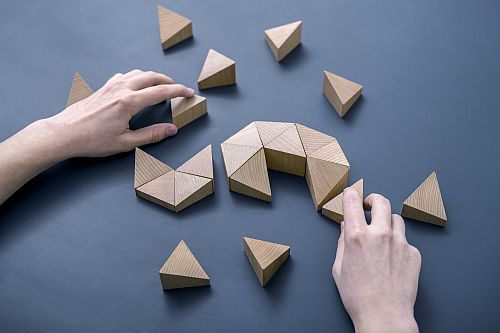
Logifaces Collaborations and Competitions
Playing with Logifaces
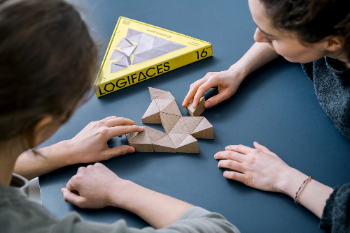
Goals and Elements of the game
Our goal is to maximize enjoyment and engagement by capturing the interest of learners and inspiring them to continue learning. Gamification, broadly defined, is the process of defining the elements which comprise games, make those games fun, and motivate players to continue playing, then using those same elements in a non-game context to influence behavior. [br][br]In other words, gamification is the introduction of game elements into a traditionally non-game situation. We have already created some collaborative and competitive game ideas based on Logifaces. Check out our videos - and we encourage you to come up with new ideas! [br][br]Contact us at [url=mailto:daniel@planbureau.hu]daniel@planbureau.hu[/url]










